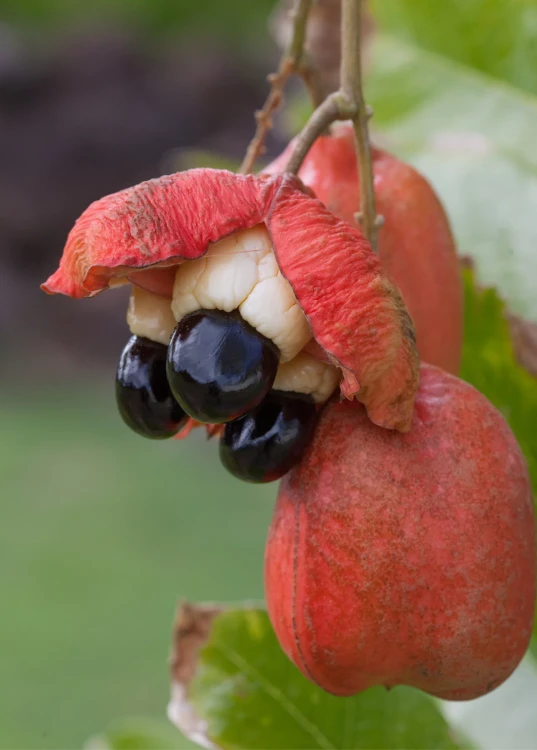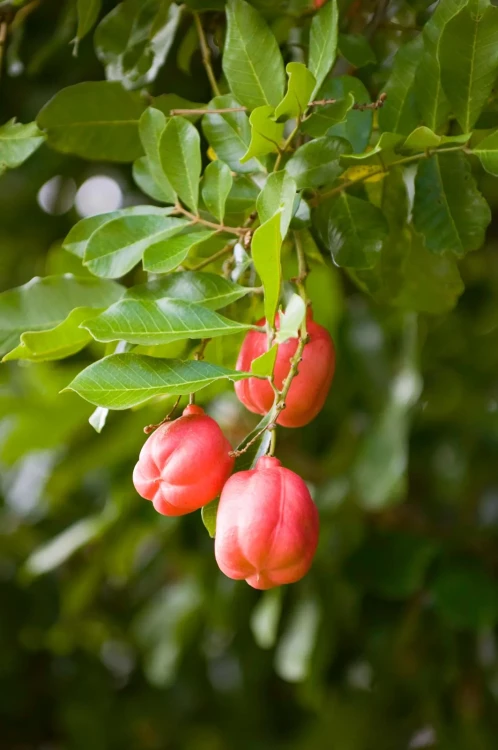- Overview
Embrace the rich flavors of Jamaica with your own Akee Tree (Blighia sapida). Our trees are specially selected to adapt to a variety of climates, allowing you to harvest the revered Akee fruit right from your garden. Each Akee Tree comes with comprehensive planting and care instructions to ensure you can enjoy these exotic fruits safely. Note: Akee fruits must be harvested when fully ripe as unripe Akee is unsafe for consumption.
Description
Origin and Distribution
Climate
Soil
Propagation and Culture
Season
Food Use
Food Value
Toxicity
Other Uses
Medicinal usesThe akee, Blighia sapida K. Konig (syn. Cupania sapida Voigt.), of the family Sapindaceae, is sometimes called ackee, akee apple, or vegetable brain (seso vegetal in Spanish). Other Spanish names are arbol de seso, palo de seso (Cuba); huevo vegetal and fruto de huevo (Guatemala and Panama); arbor del huevo and pera roja (Mexico); merey del diablo (Venezuela); bien me sabe or pan y quesito (Colombia); akí (Costa Rica). In Portuguese, it is castanha or castanheiro de Africa. In French, it is arbre fricassé or arbre a fricasser (Haiti); yeux de crabe or ris de veau (Martinique). In Surinam it is known as akie. On the Ivory Coast of West Africa, it is called kaka or finzan; in the Sudan, finza. Elsewhere in Africa it is generally known as akye, akyen or ishin, though it has many other dialectal names. In the timber trade, the wood is marketed as achin. It should be noted that the name "akee" may refer to the mamoncillo, q.v., in Barbados. As a colloquial term for the mamoncillo it may be a corruption of the Mayan "acche" which was applied to several plants whose flowers attract honeybees. The akee (Blighia sapida) from Africa is a favorite in Jamaica but the fleshy arils are poisonous until fully exposed to light. The seeds are always poisonous.
Description
The tree, reaching 33 to 40 ft (10-12 m), is rather hand some, usually with a short trunk to 6 ft ( 1.8 m) in circumference, and a dense crown of spreading branches. Its bark is gray and nearly smooth. The evergreen (rarely deciduous), alternate leaves are compound with 3 to 5 pairs of oblong, obovate-oblong, or elliptic leaflets, 6 to 12 in (15-30 cm) long, rounded at the base, short-pointed at the apex; bright-green and glossy on the upper surface, dull and paler and finely hairy on the veins on the under side. Bisexual and male flowers, borne together in simple racemes 3 to 7 in (7.5-17.5 cm) long, are fragrant, 5 petalled, white and hairy. The fruit is a leathery, pear shaped, more or less distinctly 3-lobed capsule 2 3/4 to 4 in (7-10 cm) long; basically yellow, more or less flushed with bright-scarlet. When it is fully mature, it splits open revealing 3 cream-colored, fleshy, glossy arils, crisp, somewhat nutty-flavored, attached to the large, black, nearly round, smooth, hard, shining seeds–nonnally 3; often 1 or 2 may be aborted. The base of each aril is attached to the inside of the stem-end of the "jacket" by pink or orange-red membranes.
Origin and Distribution
The akee is indigenous to the forests of the Ivory Coast and Gold Coast of West tropical Africa where it is little eaten but various parts have domestic uses. In Ghana, the fruiting tree is admired as an ornamental and is planted in villages and along streets for shade. The akee was brought to Jamaica in 1793 by the renowned Captain Bligh to furnish food for the slaves. It was readily adopted and became commonly grown in dooryards and along roadsides and, to some extent, naturalized. The arils still constitute a favorite food of the island and the fruit is featured in a calypso despite the health hazards associated with it. Canned arils are exported to the United Kingdom where they are welcomed byJamaican immigrants. Importation has been banned by the United States Food and Drug Administration. The akee was planted also in Trinidad and Haiti and some other islands of the West Indies and the Bahamas and apparently was carried by Jamaican slaves to Panama and the Atlantic Coast of Guatemala and Costa Rica. In 1900 it was outlawed in Trinidad after it had caused some fatalities. There are scattered trees in Surinam, Venezuela, Colombia, Ecuador and Brazil, quite a number maintained as curiosities in southern Florida; and some planted around Calcutta, India. The tree has been tried in the warm, moist climate of Guyana and Malaya but has never survived. At Lamao in the Philippines it first bore fruit in 1919.
Climate
The akee tree is tropical to subtropical; flourishes from sea-level to an elevation of 3,000ft (900 m) in Jamaica. It does not bear fruit in Guatemala City; fruits heavily in southern Florida where young trees have been killed by winter cold but mature trees have escaped serious injury during brief periods of 26° F (-3.33° C).
Soil
The tree does very well on oolitic limestone and on sand in southern Florida and the Bahamas, though it grows faster in more fertile soils.
Propagation and Culture
Akee trees are grown from seeds or by shield-budding, and show very little variation. In European greenhouses, cuttings of ripe shoots are rooted in sand and raised in a mixture of peat and loam. In warm climates, the tree grows fast and requires little cultural attention.
Season
There is some flowering and fruiting all year in Jamaica. In Florida, flowers appear in spring and the fruits in mid summer and there may be a light blooming period in the fall. In the Bahamas, there are 2 distinct crops a year, one from February through April and the second from July to October.
Food Uses
The akee must be allowed to open fully or at least partly before it is detached from the tree. When it has "yawned", the seeds are discarded and the arils, while still fresh and firm, are best parboiled in salted water or milk and then lightly fried in butter. Then they are really delicious. In Jamaica, they are often cooked with codfish, onions and tomatoes. After parboiling, they are added to a stew of beef, salt-pork and scallions, thyme and other seasonings. Sometimes they are curried and eaten with rice. They are served, not only in the home, but also in hotel dining rooms and other restaurants. In Africa, they may be eaten raw or in soup, or after frying in oil.
Food Value Per 100 g of Raw Arils*
Moisture 57.60 g
Protein 8.75 g
Fat 18.78 g
Fiber 3.45 g
Carbohydrates 9.55 g
Ash 1.87 g
Calcium 83 mg
Phosphorus 98 mg
Iron 5.52 mg
Carotene --
Thiamine 0.10 mg
Riboflavin 0.18 mg
Niacin 3.74 mg
Ascorbic Acid 65 mg
*Analyses made in Mexico.
Toxicity
The toxicity of the akee was long misunderstood and believed to reside in the membranes attaching the arils to the jacket, or only in the overripe and decomposing arils. There have been intensive clinical and chemical studies of the akee and its effects since 1940, and it is now known that the unripe arils contain hypoglycin, a-amino-B-(2-methylenecyclopropyl) propionic acid, formerly called hy poglycin A. This toxic property is largely dispelled by light as the jacket opens. When fully ripe, the arils still possess 1/12 of the amount in the unripe. The seeds are always poisonous. They contain hypoglycin and its y-glutamyl derivative, y-L-glutamyl a-amino-B-(2-methylene cyclopropyl) propionic acid, formerly called hypoglycin B. The latter is 1/2 as toxic as the former. In feeding experiments at the University of Miami, Dr. Edward Larson found that the membrane of open fruits was harmless; rabbits were readily killed by the unripe arils; rats were resistant and had to be force fed to be fatally poisoned. I have found that squirrels will make holes in the unopened fruits on the tree to consume the unripe arils but they leave the seeds untouched. Akee poisoning in humans is evidenced by acute vomiting, sometimes repeated, without diarrhea (called "vomiting sickness" in Jamaica), followed by drowsiness, convulsions, coma and, too often, death. Because of hypoglycaemic effects, administration of sugar solutions have been found helpful. Most cases occur in winter in Jamaica when 30% to 50% of the arils have small, underdeveloped seeds, often not apparent externally. Ingestion of such arils, raw or cooked, is hazardous. For more information on the toxicity of the akee, one may consult Kean, Hypoglycin (1975), and Morton, Forensic Medicine, Vol. III, Chap. 71 (1977).
Other Uses
Fruit: In West Africa, the green fruits, which produce lather in water, are used for laundering. Crushed fruits are employed as fish poison. The seeds, because of their oil content, and the jacket because of its potash content, are burned and the ashes used in making soap.
Flowers: In Cuba an extract of the flowers is appreciated as cologne.
Bark: On the Gold Coast, a mixture of the pulverized bark and ground hot peppers is rubbed on the body as a stimulant.
Wood: The sapwood is white or light greenish-brown. The heartwood is reddish-brown, hard, coarse-grained, durable, immune to termites. It is used locally for construction and pilings and has been recommended for railway sleepers. It is also fashioned into oars, paddles and casks.
Medicinal Uses:
In Brazil, repeated small doses of an aqueous extract of the seed has been administered to expel parasites. The treatment is followed by a saline or oily purative. Cubans blend the ripe arils with sugar and cinnamon and give the mixture as a febrifuge and as a treatment for dysentery. On the Ivory Coast, the bark is mixed with pungent spices in an ointment applied to relieve pain. The crushed new foliage is applied on the forehead to relieve severe headache. The leaves, crushed with salt, are poulticed on ulcers. The leaf juice is employed as eye drops in ophthalmia and conjunctivitis. In Colombia, the leaves and bark are considered stomachic. Various preparations are made for treatment of epilepsy and yellow fever. - Features
weight: 9.99 lbs Hardiness Zones: Zone 8 : - ReviewsThere is no reviews yet...Be the first!
Be the first to write a review of this product!





